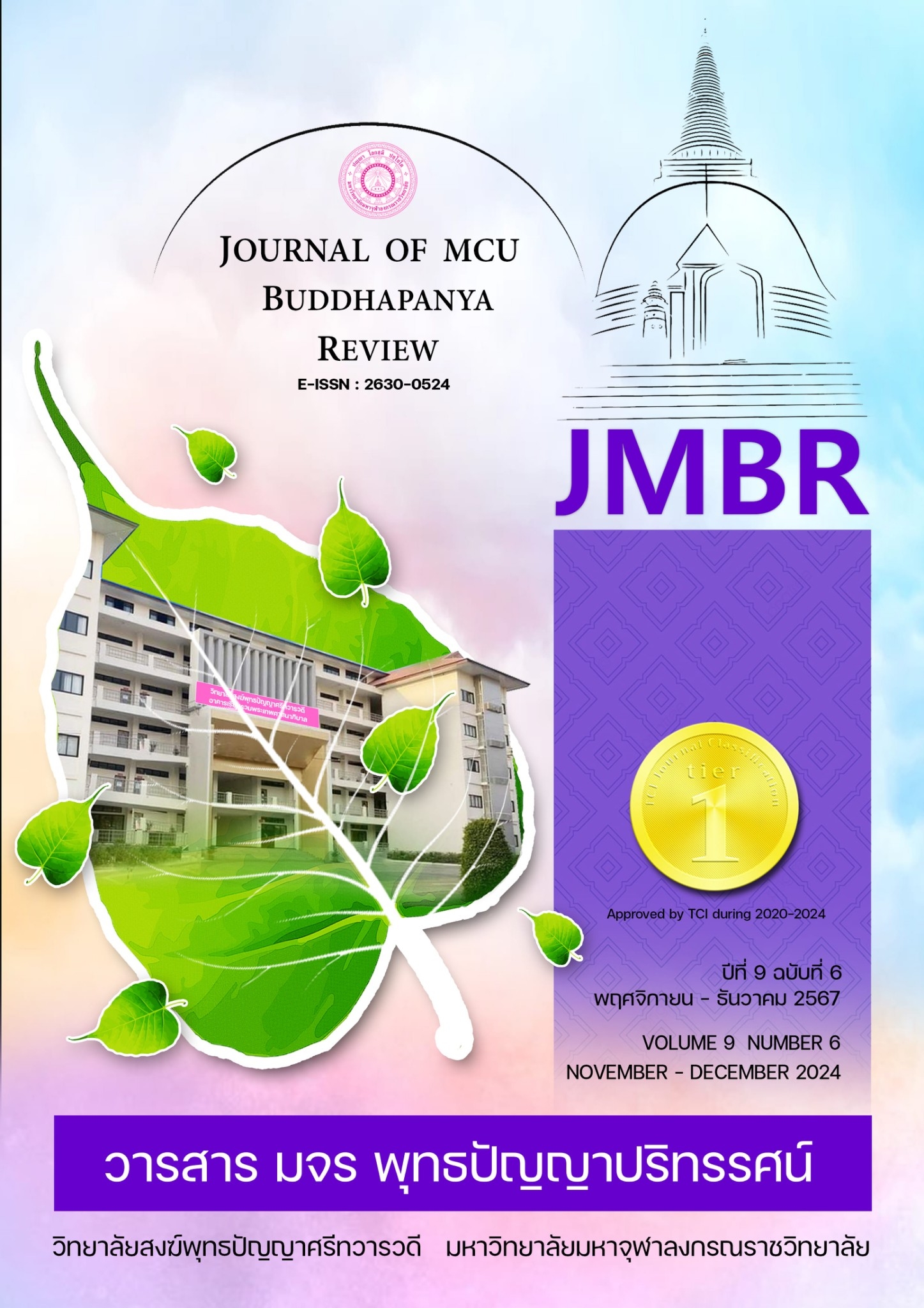บางกระทุ่มน่าชม : ยุทธศาสตร์การพัฒนาการท่องเที่ยวเชิงพระพุทธศาสนาและวัฒนธรรมอำเภอบางกระทุ่ม จังหวัดพิษณุโลก
คำสำคัญ:
ยุทธศาสตร์, การพัฒนา, การท่องเที่ยว, พระพุทธศาสนาบทคัดย่อ
บทความวิจัยนี้มีวัตถุประสงค์ 1) เพื่อศึกษาสภาพบริบททั่วไป และวิเคราะห์จุดเด่น จุดด้อย โอกาสและอุปสรรคทางการท่องเที่ยวเชิงพระพุทธศาสนาและวัฒนธรรมในอำเภอบางกระทุ่ม จังหวัดพิษณุโลก 2) เพื่อพัฒนาการท่องเที่ยวเชิงพระพุทธศาสนาและวัฒนธรรมในอำเภอบางกระทุ่ม จังหวัดพิษณุโลก แบบมีส่วนร่วมของชุมชน และ 3) เพื่อเสนอยุทธศาสตร์การพัฒนาการท่องเที่ยวเชิงพระพุทธศาสนาและวัฒนธรรมอำเภอบางกระทุ่ม จังหวัดพิษณุโลก เป็นการวิจัยเชิงคุณภาพ ผู้ให้ข้อมูลสำคัญ คือ ผู้นำชุมชน ประชาชน และหน่วยงานภาครัฐ จำนวน 40 คน ใช้วิธีคัดเลือกแบบเจาะจง เครื่องมือที่ใช้ในการวิจัย คือ แบบสัมภาษณ์ วิเคราะห์ข้อมูลโดยใช้วิเคราะห์เนื้อหาแล้วเขียนบรรยายเชิงพรรณนา
ผลการวิจัยพบว่า 1) อำเภอบางกระทุ่ม จังหวัดพิษณุโลก มีแหล่งท่องเที่ยวเชิงพระพุทธศาสนาและวัฒนธรรมที่มีความโดดเด่นและน่าสนใจ 5 แห่ง ได้แก่ วัดสนามคลีตะวันตก วัดไพรสุวรรณ วัดโคกสลุด วัดตายม และวัดย่านยาวพื้นที่อำเภอบางกระทุ่มมีศักยภาพสามารถพัฒนาการท่องเที่ยวเชิงพระพุทธศาสนาและวัฒนธรรมได้ 2) การพัฒนาการท่องเที่ยวเชิงพระพุทธศาสนาและวัฒนธรรม แบบมีส่วนร่วมของชุมชน จะต้องมีการพัฒนาด้านต่างๆ คือ ด้านการจัดโปรแกรมการท่องเที่ยว ด้านความสามารถในการเข้าถึง ด้านสิ่งดึงดูดใจ ด้านสิ่งอำนวยความสะดวก ด้านกิจกรรมส่งเสริมการท่องเที่ยว และด้านการให้บริการของแหล่งท่องเที่ยว 3) ยุทธศาสตร์การพัฒนาการท่องเที่ยวเชิงพระพุทธศาสนาและวัฒนธรรม แบบบูรณาการตามแนวพระพุทธศาสนา โดยใช้หลักพุทธธรรมสัปปายะ 7 มาบูรณาการ ทำให้ได้กลยุทธ์การจัดการเชิงยุทธศาสตร์ 4 กลยุทธ์ คือ กลยุทธ์การพัฒนาด้านกายภาพ กลยุทธ์การพัฒนาทรัพยากร กลยุทธ์การมีส่วนร่วม และกลยุทธ์การประชาสัมพันธ์และบริการ
เอกสารอ้างอิง
Chimplee, K. (2016). Guidelines for the development of cultural tourism villages in Ban Taku community, Taku Subdistrict, Pak Thong Chai District. Nakhon Ratchasima Province. Research Community Journal, 10(1), 7-19.
Freire, P., (1972). Education : The Practice of Freedom. London: Writers and Readers Publishing Cooperative.
Kittasangkha, M. et al. (2010). A study on the development of cultural tourism management potential in the upper northern region. Case study of Chiang Rai, Chiang Mai and Mae Hong Son provinces (Research Report). Chiang Rai: Chiang Rai Rajabhat University.
Misra, R.P. and Jonjo, M. (1981). The Changing Perspective of Development Problems In Misra. Hong Kong: Maruzen Investment Hong Kong.
National Health Commission. (2022). Reiterate “Community Power” is the frontline for defeating COVID-19. Retrieved Oct 2022, from https://www.nationalhealth.or.th/ en/node/1371>
Pathomkanchana, C. & Sangraksa, N. (2015). Guidelines for promoting participatory cultural tourism of the Bang Luang Market community, Bang Len District, Nakhon Pathom Province. Academic Services Journal Prince of Songkla University, Nakharin, 26(1), 118-129.
Phinthuphan, H. (1971). Our Phitsanulok. Phra Nakhon: Krung Siam Printing.
Phra Mahanarong Soikesorn. (2023). DEVELOPMENT OF TOURISM ROUTES TO PAY RESPECT TO 9 TEMPLES IN MUEANG SUPHANBURI DISTRICT, SUPHANBURI PROVINCE. Journal of MCU Buddhapanya Review, 8(6), 114-125.
Phra Sutheerattanabundit (Aphakaro) & Phra Baidikasanya Apiwanuno (Sodprasert). (2016). Strategy of tourism in Buddhism and culture of Thailand and ASEAN. Journal of MCU Buddhapanya Review, 1(2), 7-24.
Phrakru Paladsuwattanachariyakun. (2014). Strategy for developing cultural tourism using temples as the center in the Eastern Lanna Provinces. Journal of Social Academic, 7(6), 1-15.
Phrakru SakhonKunaporn. (2023). Impact of tourism management onlocal wisdominkrathum baen district, samut sakhon province. Journal of MCU Buddhapanya Review, 8(5), 220-228.
Ponsri, S. (2002). Community Development Process. Bangkok: Thaiwattanapanich.
Rodjam, C. (2013). Arts and Culture Tourism Route, Bang Kruai District, Nonthaburi Province (Research Report). Ratchapruek College, 2013).
Saenkham, T. (2011). Bang Krathum: a forgotten district that is about to be revealed. Muang Boran Journal. 37(2), 24-30.
Saenkham, T. (2018). Strategy for sustainable cultural tourism development according to Buddhism of local administrative organizations in Loei Province. (Doctoral Dissertation). Mahachulalongkornrajavidyalaya University.
Sathapanawattana, J. (2011). Nan River Basin Culture. Phitsanulok: Naresuan University.
Thongma, W. et al., (2011). Sustainable cultural tourism development of the Chinese community in the Mae Ngon River Basin, Fang District, Chiang Mai Province (Research Report), Chiang Mai: Maejo University.
Tirakanan, S. (2008). Creating variable measurement tools in social science research: A guide to practice. Bangkok: Chulalongkorn University.
Tourism Authority of Thailand. (2008). Sustainable Tourism: A Guide to the Promotion and Development of Modern Tourism. Bangkok: Tourism Authority of Thailand.
ดาวน์โหลด
เผยแพร่แล้ว
รูปแบบการอ้างอิง
ฉบับ
ประเภทบทความ
สัญญาอนุญาต
ลิขสิทธิ์ (c) 2025 วารสาร มจร พุทธปัญญาปริทรรศน์

อนุญาตภายใต้เงื่อนไข Creative Commons Attribution-NonCommercial-NoDerivatives 4.0 International License.



